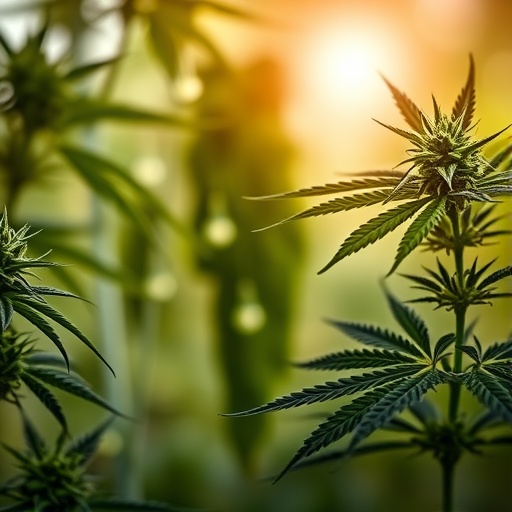In recent years, the shifting legal landscape around cannabis use has ignited intense scientific interest regarding its broader effects on human health. Among the emerging areas of concern, female fertility has come under increased scrutiny, as researchers endeavor to untangle the complex biochemical and physiological consequences of cannabis exposure on the reproductive system. A groundbreaking new study, published in Nature Communications, offers compelling evidence that cannabis use may have significant impacts on female fertility, drawing on both rigorous laboratory experiments and epidemiological data. The work, spearheaded by Duval, Wyse, Fuchs Weizman, and colleagues, provides a nuanced and detailed exploration of cannabis’s influence at the cellular level as well as in actual patient populations, highlighting previously underappreciated risks to female reproductive health.
Female fertility is governed by an intricate interplay of hormonal signaling, ovarian follicle development, and uterine receptivity, among other critical factors. These tightly regulated processes are vulnerable to disruption by exogenous substances, particularly those that interact with the endocannabinoid system—a widespread neuromodulatory network that cannabis compounds potently target. Delta-9-tetrahydrocannabinol (THC), the primary psychoactive component of cannabis, binds to cannabinoid receptors which are richly expressed not only in the brain but also within reproductive tissues. This molecular crosstalk has long suggested that cannabis could impact fertility, but until now, definitive evidence demonstrating how cannabis alters female reproductive function has been limited and sometimes contradictory.
The multidisciplinary team employed a dual approach to clarify cannabis’s effects. First, the researchers utilized state-of-the-art in vitro models of ovarian and endometrial cells derived from human tissues. By exposing these cells to controlled concentrations of THC and other cannabinoids, the team was able to observe perturbations in the expression of key reproductive proteins, hormonal receptors, and signaling pathways essential for folliculogenesis and embryonic implantation. Intriguingly, results showed significant alterations in cellular viability and endocrine functionality, indicating that cannabinoids can directly impair the cellular machinery critical for conception and early pregnancy.
What sets this study apart is the integration of these laboratory findings with a robust case-control epidemiological analysis. Enrolling over 800 women seeking fertility treatment, the study collected detailed cannabis use histories alongside clinical fertility assessments, hormone profiles, and pregnancy outcomes. After adjusting for confounders such as age, smoking status, and body mass index, cannabis users exhibited markedly reduced ovarian reserve markers and longer times to conception compared to matched controls. These data support the in vitro findings and lend strong credence to the hypothesis that cannabis consumption compromises female fertility in real-world settings.
One particularly striking observation was the dose-dependent relationship identified between frequency of cannabis use and the severity of fertility impairment. Women who reported daily or near-daily usage experienced more profound decreases in anti-Müllerian hormone (AMH) levels, a well-established biomarker for ovarian reserve, than occasional users or non-users. This gradation bolsters the biological plausibility of a causal link and emphasizes the importance of dosage and exposure duration in mediating reproductive risk. These results translate into clinical relevance, highlighting a modifiable lifestyle factor for women facing infertility challenges.
The researchers also delved into the mechanistic underpinnings of how cannabinoids exert their reproductive effects. Through molecular assays and gene expression analysis, the team uncovered disruptions in the hypothalamic-pituitary-ovarian axis and downstream signaling cascades related to follicle maturation. Cannabis exposure was associated with dysregulation of gonadotropin-releasing hormone (GnRH) expression and suppression of luteinizing hormone (LH) pulsatility, both essential for the timely ovulation and follicular rupture. Such disruption could explain observed delays in ovulation and diminished fertility at a physiological level, extending prior animal model findings into human biology.
In addition to ovarian dysfunction, the study explored endometrial receptivity, an equally critical factor for implantation success. Experiments revealed that exposure to cannabinoids detrimentally impacted endometrial stromal cells’ capacity to decidualize—a crucial hormonally mediated transformation that prepares the uterus for embryo implantation. Failure of decidualization often leads to early pregnancy loss or implantation failure, underscoring how cannabis’s deleterious effects on female fertility may extend beyond mere ovulatory deficits to multiple reproductive stages.
Compounding the clinical importance of these results, the researchers highlighted the potential intergenerational consequences of cannabis use. Emerging evidence suggests that compromised ovarian environments and abnormal implantation conditions may influence the epigenetic landscape of developing embryos, raising concerns about offspring health. While this study focused primarily on fertility parameters, the authors suggest that future research should investigate long-term developmental outcomes in children conceived by mothers exposed to cannabis.
Public health implications are profound, given the rising prevalence of cannabis use globally and its legalization in numerous regions. The common perception of cannabis as a harmless recreational drug belies its complex biological impact, especially among women in their reproductive years. This research advocates for enhanced clinical screening and counseling for cannabis use in reproductive health settings, emphasizing the need for evidence-based guidance to support women’s informed decision-making.
Clinicians and fertility specialists are encouraged to incorporate cannabis use assessment into routine evaluations and to educate patients about potential reproductive risks. This is especially pertinent since some women may unknowingly use cannabis to alleviate stress or pain related to fertility treatments, inadvertently exacerbating the very conditions they aim to improve. Tailored intervention programs and cessation support should be integrated within fertility clinics to address this emerging challenge.
From a scientific perspective, the study underscores the necessity of rigorous mechanistic and translational research bridging molecular biology with patient-centered outcomes. While the current findings establish convincing associations and biological plausibility, longitudinal cohort studies with larger and more diverse populations will be essential to fully delineate the temporal dynamics and potential reversibility of cannabis-induced reproductive impairments.
At a molecular level, clarification of the differential roles of various cannabinoids—including cannabidiol (CBD) and synthetic analogs—may reveal therapeutic windows or varying risks, offering avenues for safer medicinal applications. Moreover, understanding how cannabis interacts with other risk factors such as smoking, environmental toxins, and metabolic diseases may uncover synergistic effects with profound implications for reproductive health.
Interestingly, the study opens potential new directions for fertility research targeting the endocannabinoid system directly. Given its central role in reproductive physiology, pharmacological modulation without the psychoactive side effects of THC could represent novel therapeutic strategies. However, this demands cautious and comprehensive investigation, balancing benefits against the risks clearly highlighted by the current work.
As cannabis legalization continues to expand, public policy must grapple with these emerging scientific insights. Regulatory frameworks for cannabis products might require inclusion of reproductive health warnings, coupled with public education campaigns targeting women of childbearing age. Policymakers should also prioritize funding for reproductive health research examining cannabis’s nuanced effects, ensuring informed societal discourse based on robust evidence rather than anecdote or ideology.
Ultimately, this landmark study by Duval and colleagues marks a pivotal advance in cannabis research, illuminating the previously opaque connection between cannabis use and female fertility health. By combining in vitro mechanistic experimentation with comprehensive patient data, the researchers provide a compelling narrative that redefines how we understand cannabis’s biological footprint within reproductive biology. The implications extend beyond fertility clinics into public health, policy, and biomedical innovation, with reverberations likely to awaken a broader appreciation of cannabis’s multifaceted effects on human physiology.
As society renegotiates its relationship with cannabis, this research serves as a clarion call to balance enthusiasm with prudence. Female reproductive wellbeing—an essential pillar of population health—cannot be sidelined amid shifting cultural norms and expanding cannabis markets. Awareness, education, and ongoing scientific inquiry remain our strongest tools for safeguarding fertility while navigating an era of unprecedented cannabis accessibility.
Subject of Research: Cannabis impact on female fertility studied through in vitro experiments and a case-control clinical study.
Article Title: Cannabis impacts female fertility as evidenced by an in vitro investigation and a case-control study.
Article References:
Duval, C., Wyse, B.A., Fuchs Weizman, N. et al. Cannabis impacts female fertility as evidenced by an in vitro investigation and a case-control study. Nat Commun 16, 8185 (2025). https://doi.org/10.1038/s41467-025-63011-2
Image Credits: AI Generated
Tags: biochemical effects of cannabis on reproductioncannabis compounds and reproductive tissuescannabis effects on female fertilitycannabis use and ovarian healthendocannabinoid system and fertilityepidemiological studies on cannabis and fertilityfemale fertility research findingsfemale reproductive system and cannabisimpact of cannabis on reproductive healthrisks of cannabis use during pregnancyTHC and hormonal signalingunderstanding female fertility and cannabis





